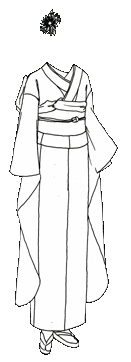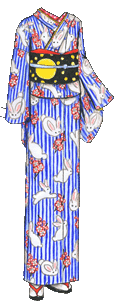 Click for larger version (PNG); click for PDF version. Click here for the list of dolls.
Click for larger version (PNG); click for PDF version. Click here for the list of dolls.
There are several types of kimono, and you can tell them apart by looking at the shape and the design. Today, we’ll just look at what you can tell from the way a kimono is cut and worn, which says quite a bit about its wearer even independent of the color, pattern or type of fabric.
The way the two sides of the kimono are crossed over each other is important for two reasons: It tells you whether the wearer is alive or dead, and about how old the person is. This first point being of some importance, if you intend to draw or wear kimono, please take care you’re doing it the right way! Living people wear kimono with the left edge lapped over the right one; corpses are dressed the opposite way. I always mix up left and right, so I find this hard to remember sometimes. In Girl Scouts, for making a square knot, I was taught “Right over left, then left over right, makes the knot neat and tidy and tight.” When trying to remember which way it is for kimono, I adapted the rhyme: “Not right over left, but left over right, will prevent nice little old ladies from being horrified at the sight of you and trying to fix your kimono right then and there.” This rhyme is maybe a little less elegant, and it is probably easier to remember that the lines should look like a “Y.” As for the other point, generally young women wear the kimono crossed high on the throat, while a slightly deeper V is how older women wear it.
The sleeves of all kimono end at the wrist bone, but the part that hangs off of the arm has significant meaning attached to it. (It’s called the furi (振り、ふり), if we’re going to get really technical, and the part that the arm actually goes through is the sode-tsuke (袖付け、そでつけ). I didn’t know those terms until I looked them up, though.) For young, unmarried women’s formal wear, that part is so long it nearly reaches the hem of the kimono, and the corner furthest from the body is rounded. For all other types of women’s kimono, that part is shorter (falling slightly below the fingers, when the arms are at the side) and less round, while for men’s kimono the corner is square.
Since the nape of the neck was traditionally considered especially alluring, the neckband of the kimono is set off from the neck. Young unmarried women, who are supposed to be the most prim and reserved, have about a fist’s worth of space from the neck to the collar; older women can set it off just a little bit more (although my book on wearing kimono, which I sense is a little on the conservative side, recommends one fist’s worth of space for everyone) while geisha wear it so low that they’re nearly showing their shoulders.
As with the way the neck is crossed, an obi tied higher on the ribcage indicates a younger wearer, and one tied a little further towards the waist indicates an older one. The obi-age (帯揚げ、おびあげ, a sash that goes under the obi and partially shows above it) is very prominent on a younger wearer, while for an older one it just slightly peeps above the obi.
The most common knot the obi is tied in is called the “taiko musubi”: this is the knot that looks rather flat and boxy. For young, unmarried women’s formal wear, it can be tied in more elaborate ways.
This kind of kimono is called a furisode, and it’s not the last time you’ll be hearing that word. Now, what can you tell me about the person wearing this kimono? If you’ve been following along carefully, you should be able to come up with five things about the wearer.
Edit: I wrote that the first one to post all five things in a comment would win my standard prize, and Janani got all of them in the first comment: the wearer is alive, female, young and unmarried, and wearing it for a formal occasion. Congratulations!
 Click for larger version (PNG); click for PDF version. Click here for the list of dolls.
Click for larger version (PNG); click for PDF version. Click here for the list of dolls. Share
Share